中英文文献翻译-驱动桥设计与分析的理论研究现状
- 格式:doc
- 大小:38.50 KB
- 文档页数:6
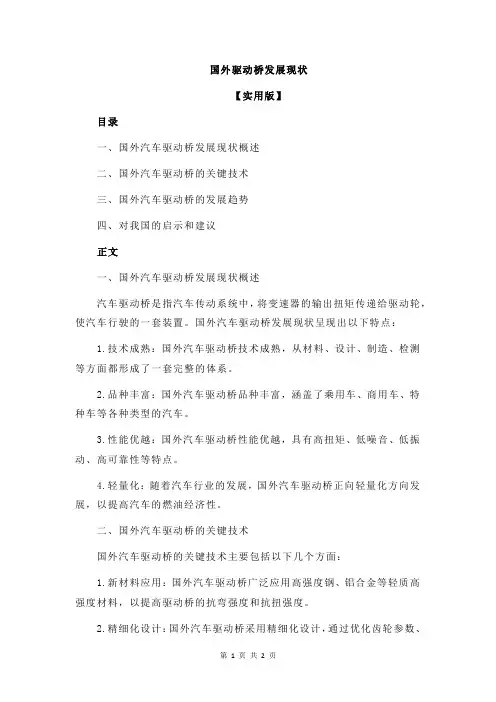
国外驱动桥发展现状【实用版】目录一、国外汽车驱动桥发展现状概述二、国外汽车驱动桥的关键技术三、国外汽车驱动桥的发展趋势四、对我国的启示和建议正文一、国外汽车驱动桥发展现状概述汽车驱动桥是指汽车传动系统中,将变速器的输出扭矩传递给驱动轮,使汽车行驶的一套装置。
国外汽车驱动桥发展现状呈现出以下特点:1.技术成熟:国外汽车驱动桥技术成熟,从材料、设计、制造、检测等方面都形成了一套完整的体系。
2.品种丰富:国外汽车驱动桥品种丰富,涵盖了乘用车、商用车、特种车等各种类型的汽车。
3.性能优越:国外汽车驱动桥性能优越,具有高扭矩、低噪音、低振动、高可靠性等特点。
4.轻量化:随着汽车行业的发展,国外汽车驱动桥正向轻量化方向发展,以提高汽车的燃油经济性。
二、国外汽车驱动桥的关键技术国外汽车驱动桥的关键技术主要包括以下几个方面:1.新材料应用:国外汽车驱动桥广泛应用高强度钢、铝合金等轻质高强度材料,以提高驱动桥的抗弯强度和抗扭强度。
2.精细化设计:国外汽车驱动桥采用精细化设计,通过优化齿轮参数、轴承布置等,提高驱动桥的性能。
3.制造工艺:国外汽车驱动桥采用先进的制造工艺,如热处理、磨齿、齿轮啮合检测等,保证驱动桥的质量。
4.检测技术:国外汽车驱动桥采用先进的检测技术,如齿轮误差检测、轴承磨损检测等,确保驱动桥的可靠性。
三、国外汽车驱动桥的发展趋势随着汽车行业的发展,国外汽车驱动桥的发展趋势主要表现在以下几个方面:1.电动化:随着新能源汽车的发展,国外汽车驱动桥正向电动化方向发展,以满足新能源汽车的高扭矩需求。
2.智能化:随着智能驾驶技术的发展,国外汽车驱动桥正向智能化方向发展,实现驱动桥的自动控制。
3.轻量化:随着汽车燃油经济性的要求越来越高,国外汽车驱动桥将继续向轻量化方向发展。
4.集成化:为了提高汽车的空间利用率,国外汽车驱动桥正向集成化方向发展,实现驱动桥与其他零部件的整合。
四、对我国的启示和建议面对国外汽车驱动桥的发展现状,我国应采取以下措施:1.加强技术研究:我国应加强对汽车驱动桥关键技术的研究,提高驱动桥的性能。
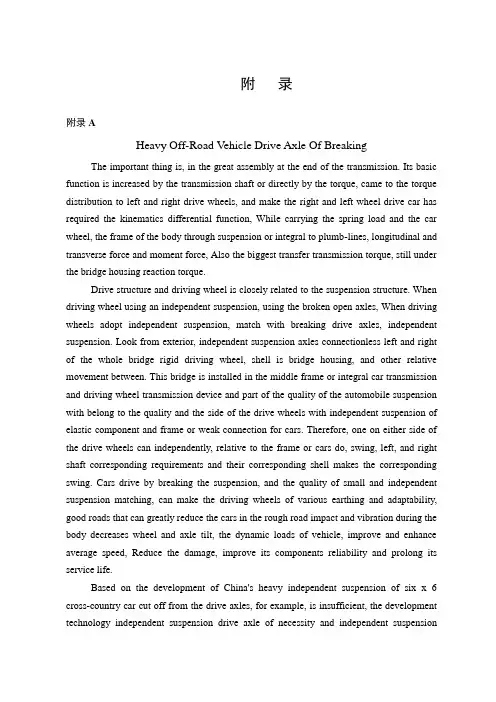
附录附录AHeavy Off-Road Vehicle Drive Axle Of BreakingThe important thing is, in the great assembly at the end of the transmission. Its basic function is increased by the transmission shaft or directly by the torque, came to the torque distribution to left and right drive wheels, and make the right and left wheel drive car has required the kinematics differential function, While carrying the spring load and the car wheel, the frame of the body through suspension or integral to plumb-lines, longitudinal and transverse force and moment force, Also the biggest transfer transmission torque, still under the bridge housing reaction torque.Drive structure and driving wheel is closely related to the suspension structure. When driving wheel using an independent suspension, using the broken open axles, When driving wheels adopt independent suspension, match with breaking drive axles, independent suspension. Look from exterior, independent suspension axles connectionless left and right of the whole bridge rigid driving wheel, shell is bridge housing, and other relative movement between. This bridge is installed in the middle frame or integral car transmission and driving wheel transmission device and part of the quality of the automobile suspension with belong to the quality and the side of the drive wheels with independent suspension of elastic component and frame or weak connection for cars. Therefore, one on either side of the drive wheels can independently, relative to the frame or cars do, swing, left, and right shaft corresponding requirements and their corresponding shell makes the corresponding swing. Cars drive by breaking the suspension, and the quality of small and independent suspension matching, can make the driving wheels of various earthing and adaptability, good roads that can greatly reduce the cars in the rough road impact and vibration during the body decreases wheel and axle tilt, the dynamic loads of vehicle, improve and enhance average speed, Reduce the damage, improve its components reliability and prolong its service life.Based on the development of China's heavy independent suspension of six x 6 cross-country car cut off from the drive axles, for example, is insufficient, the development technology independent suspension drive axle of necessity and independent suspensiondrive axle of structural principle in aspects of heavy off-road vehicle drive with independent suspension of this development.1 Domestic independent suspension drive technology situationAt present domestic independent suspension axles in cars, light off-road vehicle and JN252 8 x 8, etc ZhongDunWei military car has been applied and independent suspension heavy off-road vehicle axles technology is basically blank, Foreign independent suspension heavy off-road vehicle axles technology also only by American company, belarus, Minsk Sisu, Finland has TIMONEY company and Korea etc, and application scope of military and civilian limitations in some special models.2 Develop independent suspension drive axle of necessityIn recent years, with independent suspension off-road vehicle market demand more and more widely. Restrict independent suspension off-road vehicle development is one of the key factors, thus breaking drive axles of the necessity of developing broken off.2.1Military car development needsCurrently our extensive use of grade 6 x 6 type 7t SX2190 models is shaanxi automobile manufacturing factory using STEYR technology development of new generation rover, has good performance, and strong adaptability, good performance advantages over the past 20 years for national defense construction made great contribution. The truck with 8 x 8 upward-leading continuous casting.the JN2270 15t and capability of type x 8 August JN2300 type, the successful development of China's second DaiJun car development was at an end. In order to adapt to the needs of modern war, the third DaiJun car development was put on the agenda. Article DaiJun car features for independent suspension of high performance of motor vehicles. As its core technology is one of the big Hollywood drive shaft cut off, domestic blank, basic is dependence on imports, if do not accord with national also does not conform to the military.2.2The basic needs of national constructionFor many years, our national economy is developing rapidly, and infrastructure investment growth, hydroelectric power, oil field, mine, coal and other industries such as fire like tea. The industry is inseparable from the high quality, the high performance of transport vehicles, independent suspension off-road vehicle is among the top. However, these vehicles almost entirely on imports, spent a great deal of foreign exchange. To develop a replacement model is of great significance to meet the market demand.3 Independent suspension structure theory. Drive axle ofChina's heavy automobile group company with development and production status, independent development drive axle of the independent suspension 6 x 6 cross-country car drive shaft cut off big Hollywood. According to 6 x 6 independent suspension chassis design requirements, in this model adopted high transmission fault type axles. The first thing is to cut off to drive, high of double bridge for breaking through the medium-sized Bridges, rear axles turn for breaking steering of high axles. Three bridge are installed with gas control differential between the wheel lock differential, medium-sized Bridges across the bridge box installed with gas control differential between the lock shaft differential. Main reducer ratio for 1 2023, gear ratio for 4. 26 (belt wheel side filling put gas system, ABS), the total ratio 7.016, The medium-sized Bridges for Φ 180 input end tooth flanges, output for Φ 165 end flange, rear axle gears before the input for Φ 165 end tooth flange, Each shaft axis for jose 13t. This design is mainly in steyr drive technology based on the development and design, design thoughts and 6 x is 6, 8 x 8, 10 December 10, military USES 10 series assemblies, reduce the new design of special parts. 8 x 8 middle bridge, 10 assembly, 10, and 12 million spxillion structure types are similar. The new design two broken open bridge, front axle shell adopts the breakthrough in the shell, type of bridge, using the same type of the rear axle housing learnings. On the basis of that, left, right, two kinds of half axle and cover and spline set assembly, and on the reduction and bridge box shell and the local improvement. High technology to drive the corresponding design. Before using high to drive axle of bridge structure, thus make the box with the same drive axle of center distance of the bridge, i.e. input than the original structure of flange steyr 100mm up front axle and bridge, can satisfy the same height flange vehicle transmission Angle to decorate the small request. Before turning mainly by high drive axles, before breaking casting bridge in the middle of the disc brake, using the shell with the filling of the deflated wheelhub ball cage patterned assembly, universal shaft coupling assembly etc. And now the thing turn compared with has the following characteristics: ①Using steel bridge housing, good rigidity, high strength.②Using steyr mature main reducer and axle box of bridge structure of the existing technology (without prior to drive axle box structure), improve cross the bridge reliability.③Using the ball cage patterned double gimbal couplings, can make the centerline of ball cage with to the center of the kingpin always in line with the wheels, reduce sliding wear.4 conclusionWith independent suspension car of rapid development, large-tonnage breaking drive axle of development of necessity and urgency. It not only can greatly improve the car ride and mobility, also for automobile driving performance such as power, economy, and has a direct impact on the stability, etc. Both can satisfy the military modernization needs, also can meet the needs of the development of national economy, therefore has the important practical significance.附录B重型越野汽车断开式驱动桥的研发驱动桥是汽车的重要大总成 ,处于传动系的末端。
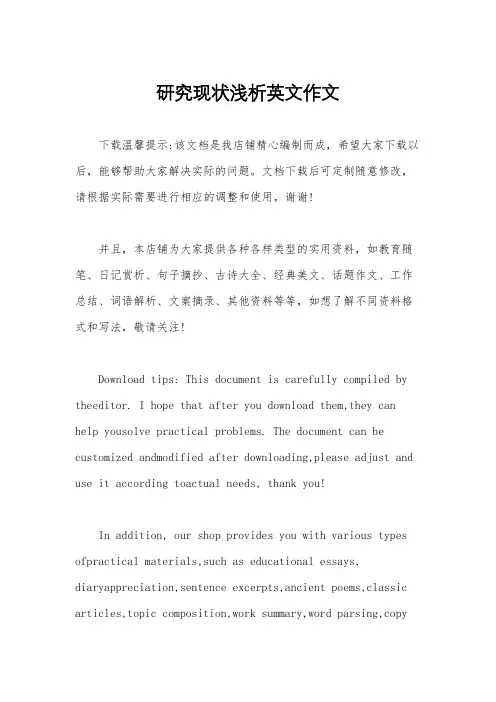
研究现状浅析英文作文下载温馨提示:该文档是我店铺精心编制而成,希望大家下载以后,能够帮助大家解决实际的问题。
文档下载后可定制随意修改,请根据实际需要进行相应的调整和使用,谢谢!并且,本店铺为大家提供各种各样类型的实用资料,如教育随笔、日记赏析、句子摘抄、古诗大全、经典美文、话题作文、工作总结、词语解析、文案摘录、其他资料等等,如想了解不同资料格式和写法,敬请关注!Download tips: This document is carefully compiled by theeditor. I hope that after you download them,they can help yousolve practical problems. The document can be customized andmodified after downloading,please adjust and use it according toactual needs, thank you!In addition, our shop provides you with various types ofpractical materials,such as educational essays, diaryappreciation,sentence excerpts,ancient poems,classic articles,topic composition,work summary,word parsing,copyexcerpts,other materials and so on,want to know different data formats andwriting methods,please pay attention!Nowadays, a lot of research is going on in various fields. In science, new discoveries are being made all the time. Scientists are constantly exploring and experimenting.In technology, things are advancing at a rapid pace. New gadgets and apps are coming out every day. It's really amazing to see how far we've come.In the social sciences, there's a lot of interest in understanding human behavior and society. Different studies are looking at different aspects of our lives.And in the arts, there are always new interpretations and creations. Artists are constantly pushing theboundaries and trying new things.。
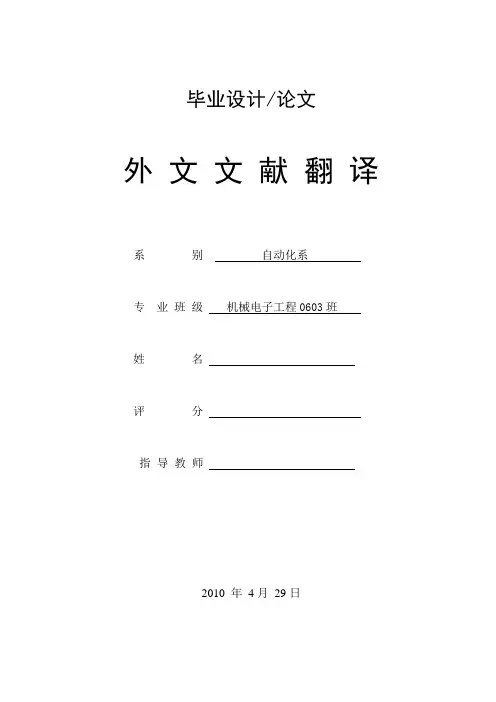
毕业设计/论文外文文献翻译系别自动化系专业班级机械电子工程0603班姓名评分指导教师2010 年4月29日毕业设计/论文外文文献翻译要求:1.外文文献翻译的内容应与毕业设计/论文课题相关。
2.外文文献翻译的字数:非英语专业学生应完成与毕业设计/论文课题内容相关的不少于2000汉字的外文文献翻译任务(其中,汉语言文学专业、艺术类专业不作要求),英语专业学生应完成不少于2000汉字的二外文献翻译任务。
格式按《华中科技大学武昌分校本科毕业设计/论文撰写规范》的要求撰写。
3.外文文献翻译附于开题报告之后:第一部分为译文,第二部分为外文文献原文,译文与原文均需单独编制页码(底端居中)并注明出处。
本附件为封面,封面上不得出现页码。
4.外文文献翻译原文由指导教师指定,同一指导教师指导的学生不得选用相同的外文原文。
驱动桥设计随着汽车对安全、节能、环保的不断重视,汽车后桥作为整车的一个关键部件,其产品的质量对整车的安全使用及整车性能的影响是非常大的,因而对汽车后桥进行有效的优化设计计算是非常必要的。
驱动桥处于动力传动系的末端,其基本功能是增大由传动轴或变速器传来的转矩,并将动力合理地分配给左、右驱动轮,另外还承受作用于路面和车架或车身之间的垂直力力和横向力。
驱动桥一般由主减速器、差速器、车轮传动装置和驱动桥壳等组成。
驱动桥作为汽车四大总成之一,它的性能的好坏直接影响整车性能,而对于载重汽车显得尤为重要。
驱动桥设计应当满足如下基本要求:1、符合现代汽车设计的一般理论。
2、外形尺寸要小,保证有必要的离地间隙。
3、合适的主减速比,以保证汽车的动力性和燃料经济性。
4、在各种转速和载荷下具有高的传动效率。
5、在保证足够的强度、刚度条件下,力求质量小,结构简单,加工工艺性好,制造容易,拆装,调整方便。
6、与悬架导向机构运动协调,对于转向驱动桥,还应与转向机构运动协调。
智能电子技术在汽车上得以推广使得汽车在安全行驶和其它功能更上一层楼。
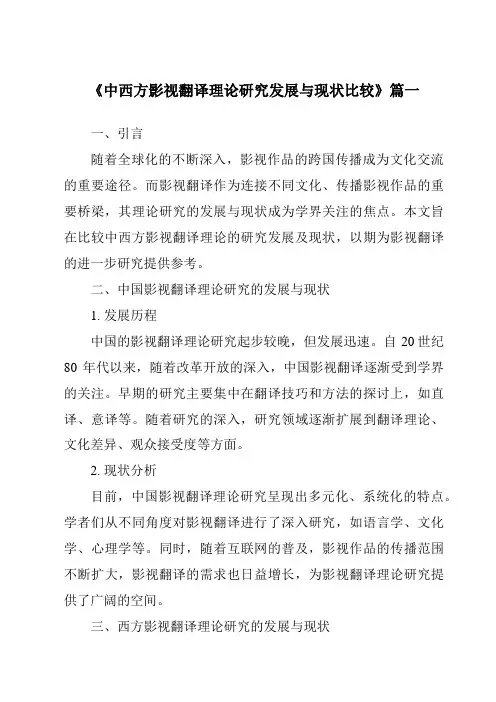
《中西方影视翻译理论研究发展与现状比较》篇一一、引言随着全球化的不断深入,影视作品的跨国传播成为文化交流的重要途径。
而影视翻译作为连接不同文化、传播影视作品的重要桥梁,其理论研究的发展与现状成为学界关注的焦点。
本文旨在比较中西方影视翻译理论的研究发展及现状,以期为影视翻译的进一步研究提供参考。
二、中国影视翻译理论研究的发展与现状1. 发展历程中国的影视翻译理论研究起步较晚,但发展迅速。
自20世纪80年代以来,随着改革开放的深入,中国影视翻译逐渐受到学界的关注。
早期的研究主要集中在翻译技巧和方法的探讨上,如直译、意译等。
随着研究的深入,研究领域逐渐扩展到翻译理论、文化差异、观众接受度等方面。
2. 现状分析目前,中国影视翻译理论研究呈现出多元化、系统化的特点。
学者们从不同角度对影视翻译进行了深入研究,如语言学、文化学、心理学等。
同时,随着互联网的普及,影视作品的传播范围不断扩大,影视翻译的需求也日益增长,为影视翻译理论研究提供了广阔的空间。
三、西方影视翻译理论研究的发展与现状1. 发展历程西方的影视翻译理论研究起步较早,可以追溯到20世纪初。
早期的研究主要集中在语言学和心理学方面,如语音、语调、语境等对翻译的影响。
随着研究的深入,研究领域逐渐扩展到文化交流、跨文化传播、观众接受度等方面。
2. 现状分析目前,西方的影视翻译理论研究已经相对成熟,形成了较为完善的理论体系。
学者们不仅关注翻译技巧和方法,还注重文化差异、观众心理、跨文化传播等方面的研究。
同时,随着科技的发展,影视作品的制作和传播方式不断更新,为影视翻译理论研究提供了新的挑战和机遇。
四、中西方影视翻译理论研究的比较1. 研究方法的比较中西方影视翻译理论研究在研究方法上存在一定差异。
中国学者注重从理论和实践相结合的角度进行研究,注重实证分析和案例分析。
而西方学者则更注重理论构建和跨学科研究,如心理学、社会学等在影视翻译研究中的应用。
2. 研究领域的比较在研究领域方面,中西方影视翻译理论研究都涉及翻译技巧、文化差异、观众接受度等方面。
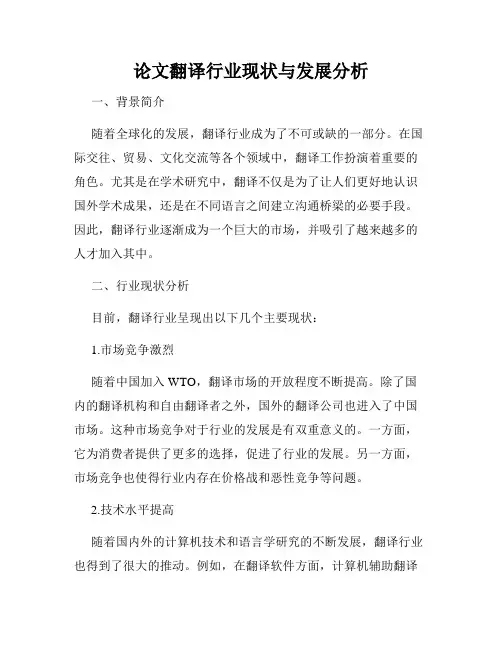
论文翻译行业现状与发展分析一、背景简介随着全球化的发展,翻译行业成为了不可或缺的一部分。
在国际交往、贸易、文化交流等各个领域中,翻译工作扮演着重要的角色。
尤其是在学术研究中,翻译不仅是为了让人们更好地认识国外学术成果,还是在不同语言之间建立沟通桥梁的必要手段。
因此,翻译行业逐渐成为一个巨大的市场,并吸引了越来越多的人才加入其中。
二、行业现状分析目前,翻译行业呈现出以下几个主要现状:1.市场竞争激烈随着中国加入WTO,翻译市场的开放程度不断提高。
除了国内的翻译机构和自由翻译者之外,国外的翻译公司也进入了中国市场。
这种市场竞争对于行业的发展是有双重意义的。
一方面,它为消费者提供了更多的选择,促进了行业的发展。
另一方面,市场竞争也使得行业内存在价格战和恶性竞争等问题。
2.技术水平提高随着国内外的计算机技术和语言学研究的不断发展,翻译行业也得到了很大的推动。
例如,在翻译软件方面,计算机辅助翻译(CAT)软件的应用已经非常普及,它可以提高翻译效率,减少翻译成本。
此外,自然语言处理技术的不断进步也为翻译提高了准确性和效率。
3.职业化程度提高翻译行业经历了从“配音员”、“口译员”到“翻译员”的转变,职业化程度得到了很大的提高。
如今,国内外的翻译机构普遍要求翻译人员具有相关专业背景,能够达到一定的文化素养和语言水平。
虽然自由翻译者没有这些要求,但也需要具备丰富的知识和专业能力。
三、行业发展趋势分析未来的翻译市场将会呈现一些明显的趋势:1.全球化市场的扩张全球化市场的扩张是未来翻译行业的一个重要趋势。
中国已经成为了全球第二大经济体,越来越多的国际公司把目光投向了中国市场。
与此同时,中国企业也开始走向国际化。
这样的背景下,翻译行业将会受到更多的关注和需求。
2.智能化应用的普及在未来,随着智能化技术的不断发展和应用,翻译行业也将会迎来智能化应用的大爆发。
例如,人工智能翻译、语音识别等技术的应用将会在翻译行业中发挥越来越重要的作用。
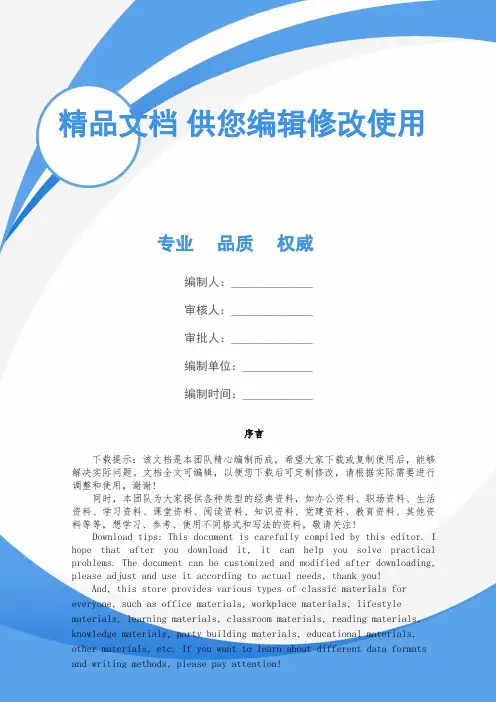
精品文档供您编辑修改使用专业品质权威编制人:______________审核人:______________审批人:______________编制单位:____________编制时间:____________序言下载提示:该文档是本团队精心编制而成,希望大家下载或复制使用后,能够解决实际问题。
文档全文可编辑,以便您下载后可定制修改,请根据实际需要进行调整和使用,谢谢!同时,本团队为大家提供各种类型的经典资料,如办公资料、职场资料、生活资料、学习资料、课堂资料、阅读资料、知识资料、党建资料、教育资料、其他资料等等,想学习、参考、使用不同格式和写法的资料,敬请关注!Download tips: This document is carefully compiled by this editor. I hope that after you download it, it can help you solve practical problems. The document can be customized and modified after downloading, please adjust and use it according to actual needs, thank you!And, this store provides various types of classic materials for everyone, such as office materials, workplace materials, lifestylematerials, learning materials, classroom materials, reading materials, knowledge materials, party building materials, educational materials, other materials, etc. If you want to learn about different data formats and writing methods, please pay attention!中西方影视翻译理论探究进步与现状比较一、引言随着全球化的不息进步和影视产业的高速进步,中西方影视翻译在全球范围内逐渐成为翻译界的探究热点。

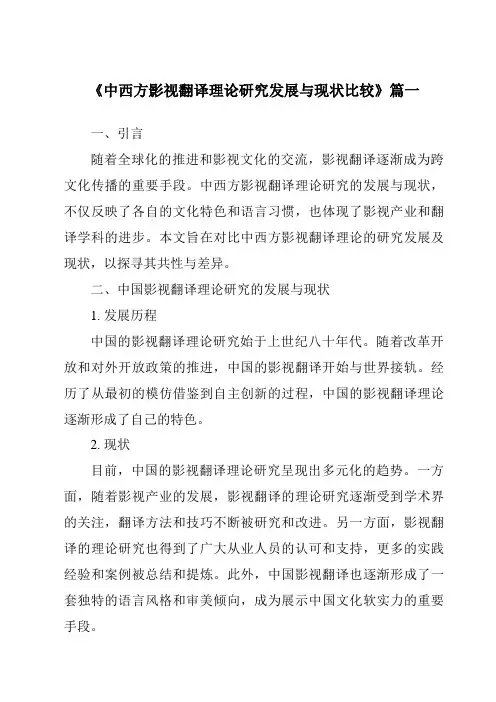
《中西方影视翻译理论研究发展与现状比较》篇一一、引言随着全球化的推进和影视文化的交流,影视翻译逐渐成为跨文化传播的重要手段。
中西方影视翻译理论研究的发展与现状,不仅反映了各自的文化特色和语言习惯,也体现了影视产业和翻译学科的进步。
本文旨在对比中西方影视翻译理论的研究发展及现状,以探寻其共性与差异。
二、中国影视翻译理论研究的发展与现状1. 发展历程中国的影视翻译理论研究始于上世纪八十年代。
随着改革开放和对外开放政策的推进,中国的影视翻译开始与世界接轨。
经历了从最初的模仿借鉴到自主创新的过程,中国的影视翻译理论逐渐形成了自己的特色。
2. 现状目前,中国的影视翻译理论研究呈现出多元化的趋势。
一方面,随着影视产业的发展,影视翻译的理论研究逐渐受到学术界的关注,翻译方法和技巧不断被研究和改进。
另一方面,影视翻译的理论研究也得到了广大从业人员的认可和支持,更多的实践经验和案例被总结和提炼。
此外,中国影视翻译也逐渐形成了一套独特的语言风格和审美倾向,成为展示中国文化软实力的重要手段。
三、西方影视翻译理论研究的发展与现状1. 发展历程西方的影视翻译理论研究历史悠久,其发展历程大致可划分为四个阶段:初期探索、语言对比与文化研究、多元系统论及后现代主义理论。
随着电影和电视的普及,西方学者开始关注影视翻译的特性和规律,形成了较为完善的理论体系。
2. 现状目前,西方的影视翻译理论研究注重跨文化交际、功能主义、文化研究和多模态话语分析等方面。
其研究方法和技术不断更新,更加注重实证研究和数据驱动。
同时,西方影视翻译也形成了自己的特色和风格,成为文化交流的重要手段。
四、中西方影视翻译理论的比较1. 共性中西方影视翻译理论在发展过程中都注重跨文化交际和文化交流的重要性。
同时,两者都致力于探索影视翻译的特性和规律,形成了较为完善的理论体系。
此外,随着科技的发展和多媒体的普及,中西方影视翻译都开始关注多模态话语分析和人工智能在翻译中的应用。
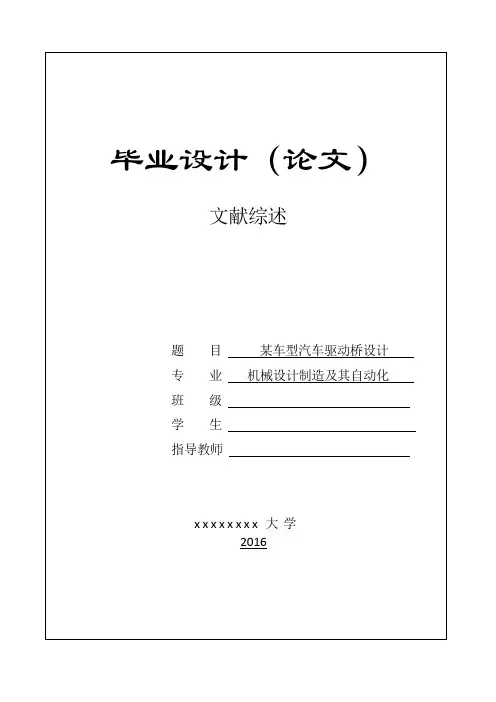
毕业设计(论文)文献综述题目某车型汽车驱动桥设计专业机械设计制造及其自动化班级学生指导教师x x x x x x x x大学2016摘要驱动桥作为汽车的四大总成之一位于汽车传动系统末端,一般由主减速器、车轮传动装置、差速器和驱动桥壳等组成。
驱动桥在整车系统的功能是增大由传动轴或变速器传来的转矩,并将动力合理的分配给左、右驱动轮,实现汽车行驶运动中所要求的左、右驱动轮的差速功能。
它的性能的好坏直接影响着汽车整车性能的好坏,所以驱动桥对于汽车非常重要。
同时汽车在行驶的过程中面临的道路环境多种多样,这样就使得驱动桥的工作环境变得极其恶劣,要承受来自路面和车体的各种振动、冲击和作用力。
而汽车在运行过程中的平顺性、舒适性、耐久性、通过性、振动噪声、传动效率都与驱动桥密切相关[1]。
本文主要介绍汽车驱动桥的研发现状、发展前景、应用现状、内部主要零件的组成、传动方案等。
关键词:汽车驱动桥,模块化设计,开发模式,整体性能,车桥市场前言随着我国经济的不断发展,目前我国已经成为世界第二大经济体,在经济发展的同时我国的汽车工业也迅猛的发展壮大,汽车工业随之带动了个汽车领域的零部件相关的产业链的发展。
驱动桥作为汽车四大总成之一,也跟随着汽车工业的发展而得到了相应的发展,国内的零部件厂家已经在研发生产过程中逐步形成了专业化、系列化、批量化生产的局面。
驱动桥位于汽车动力传动系的末端,其主要部分为:主减速器(轮边减速器)、差速器、车轮传动装置和驱动桥壳等,驱动桥的基本功能是传递扭矩、增大扭矩,同时合理的将扭矩分配给左、右驱动轮并实现差速功能,还需要承受各种复杂的力的作用。
驱动桥还对整车的机械性、可靠性、经济性等起着至关重要的作用。
虽然目前我国汽车工业已经得到了一定的发展,但就汽车驱动桥方面而言,我国仍旧存在诸多需要继续提升的地方,例如我们自主的研发能力还是有一定的局限性,现代先进的电子技术运用在产品的研发生产上的不够全面,现代产品设计分析方法没有得到充分的运用,生产自动化、智能化不够明显等。
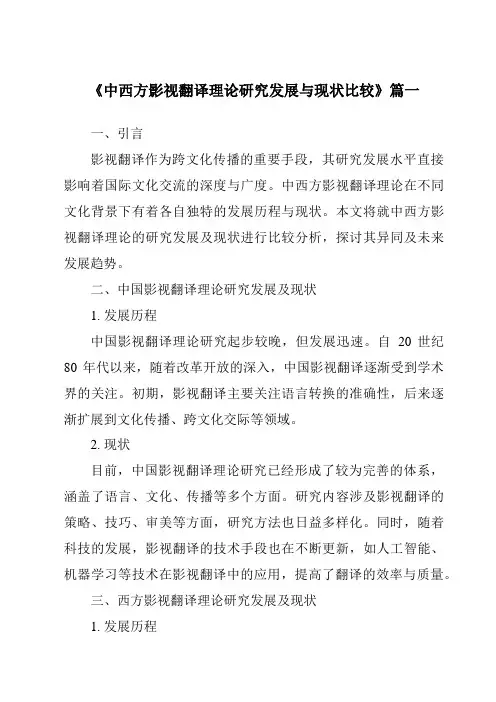
《中西方影视翻译理论研究发展与现状比较》篇一一、引言影视翻译作为跨文化传播的重要手段,其研究发展水平直接影响着国际文化交流的深度与广度。
中西方影视翻译理论在不同文化背景下有着各自独特的发展历程与现状。
本文将就中西方影视翻译理论的研究发展及现状进行比较分析,探讨其异同及未来发展趋势。
二、中国影视翻译理论研究发展及现状1. 发展历程中国影视翻译理论研究起步较晚,但发展迅速。
自20世纪80年代以来,随着改革开放的深入,中国影视翻译逐渐受到学术界的关注。
初期,影视翻译主要关注语言转换的准确性,后来逐渐扩展到文化传播、跨文化交际等领域。
2. 现状目前,中国影视翻译理论研究已经形成了较为完善的体系,涵盖了语言、文化、传播等多个方面。
研究内容涉及影视翻译的策略、技巧、审美等方面,研究方法也日益多样化。
同时,随着科技的发展,影视翻译的技术手段也在不断更新,如人工智能、机器学习等技术在影视翻译中的应用,提高了翻译的效率与质量。
三、西方影视翻译理论研究发展及现状1. 发展历程西方影视翻译理论研究历史悠久,可以追溯到20世纪初。
早期,影视翻译主要关注语言层面的转换,后来逐渐拓展到文化、社会、心理等多个领域。
在研究方法上,西方学者注重实证研究与跨学科研究,将影视翻译置于更广泛的语境中进行研究。
2. 现状西方影视翻译理论研究已经形成了较为成熟的体系,研究领域广泛,包括语言学、心理学、社会学等多个学科。
研究内容涉及影视翻译的策略、文化传播、跨文化交际等方面。
同时,随着全球化进程的加速,西方影视作品在全球范围内的传播为影视翻译理论提供了丰富的实践案例。
四、中西方影视翻译理论比较1. 异同点中西方影视翻译理论在研究内容上具有共性,都关注语言转换的准确性、文化传播的效果以及跨文化交际的挑战等方面。
然而,由于中西方文化背景、思维方式、价值观念等方面的差异,使得两国在影视翻译理论的研究方法、研究重点以及应用领域等方面存在一定差异。
例如,中国学者更注重影视翻译在文化传播中的作用,而西方学者则更注重实证研究与跨学科研究。
中国文学翻译现状分析与思考作者:祝东江来源:《吉林省教育学院学报·上旬刊》 2015年第5期祝东江(郧阳师范高等专科学校外语系,湖北十堰442000)摘要:2012年,中国作家莫言获得诺贝尔文学奖,百年梦圆让人兴奋,也让人深思。
莫言获奖,翻译有功,这使我们认识到文学翻译的重要性,同时,也认清了我国翻译滞后的现状阻碍了中国文学、文化的国际化步伐。
文学翻译是译语社会中的独特文化构建行为,意义重大。
本文分析了中国文学翻译现状以及文学翻译的相关理论和要求,同时提出了改进中国文学翻译现状的看法和思考。
关键词:莫言;中国文学;翻译现状;文学翻译DOI:10.16083/ki.22-1296/g4.2015.05.058中图分类号:I024 文献标识码:A 文章编号:1671—1580(2015)05—0131—03收稿日期:2014—11—15作者简介:祝东江(1976—),男,湖北郧西人。
郧阳师范高等专科学校外语系,副教授,研究方向:翻译理论与实践,英美文化。
莫言,山东高密人,2012年成为第一个获得诺贝尔文学奖的中国作家。
这是他个人的荣誉,更是国际文坛对中国现当代文学的肯定,而不可忽视的是莫言作品的译作家们的功劳。
中国作家百年梦圆让人兴奋,也让人深思。
在中国近代史上,对文学做出巨大贡献且具有影响力的作家造诣在莫言之上者比比皆是,为何我们迟了半个世纪才等来这一荣誉?《新杂志》主编严峰认为,莫言获奖得益于两个方面,即作品本身的实力和其国际化接受程度。
当莫言成为首位获得诺贝尔文学奖的中国作家时,其作品的瑞典语译者陈安娜也成为中国读者关注的焦点。
莫言获奖让我们看到了文学翻译的重要性及我国翻译滞后的现状,获奖并不能掩盖中国当代文学对外翻译出版的尴尬局面。
为加强不同国家和人民之间的交流与合作、理解与认可,中国认识世界或展示“中国形象”以及世界认识中国都需要翻译这个媒介,尤其是需要中国文学翻译来化解外界对中国的陌生与偏见。
毕业设计(论文)外文资料翻译系别:专业:班级:姓名:学号:外文出处:土木工程网附件: A.英文文献; B. 译文附录A英文文献BridgesBridges are great symbols of mankind’s conquest of space.The sight of the crimson tracery of the Golden Gate Bridge against a setting sun in the Pacific Ocean, or the atch of the Garabit Biaduct soaring triumphantly above the deep gorge. Fills one’s heart with wonder and admiration for the art of their builders[11]. They are the enduring expressions of mankind’s determination to remove all barriers in its pursuit of a better and freer world. Their design and building schemes are conceived in dream-like bisions. But vision and determination are not enough. All the physical forces of nature and gravity must be understood with mathematical precision and such forces have to be resisted by manipulating the right materials in the right pattern. This requires both the inspiration of an artist and the skill of an artisan.Scientific knowledge about materials and structural behavior has expanded tremendously, and computing techniques are now widely available to manipulate complex theories in innumerable ways very quickly. Engineers have virtually revolutionized bridge design and construction methods in the past decade. The advances apply to short-medium and long-span bridges.For permanent bridge,the most commonly used materials are steel and concrete. Bridge of many different type are built with these materials, used singly or in combination. Timber may be used for temporary above-water construction, for the elements of a structure that lie below the waterline (particularly timber pile s), or for short-span bridges located on secondary roads. A few short-span aluminum bridges have been built in the United States on an experimental basis.The principal portions of a bridge may be said to be the “substructure” and the “superstructure.” This division is used here simply for convenience, since in many bridges there is no clear dividing lint between the two.Common elements of the substructure are abutments (usually at the bridge ends) and piers (between the abutments).Piers and abutments often rest on separately constructed foundations such as concrete spread footings or groups of bearing piles;these foundations are part of the substructure. Occasionally a bridge substructure comprises a series of pile bents in which the piles extend above the waterline and are topped by a pile cap that, in turn, supports the major structural elements of the superstructure. Such bents often are used in arepetitive fashion as part of along, low, over-water crossing.In recent years, the dividing lines between short-medium and long-span bridge have blurred somewhat. Currently, spans of 20 to 100 ft (6.1 to 30.5m) are regarded as short by many designers, who have developed many standardized designs to handle these spans economically. Medium spans range up to, per-haps, 400ft (121.9m) in modern bridge practice, depending on the organization involved and the materials used. Long spans range up to 4000ft (1219.2m) or more, but a clear span above 1000ft (304.8m)is comparatively rare.In the United States, highway bridges generally must meet loading, design, and construction requirements of the AASHTO Specification. The design and construction of railway bridges are governed by provisions of the AREA Manual for Railway Engineering. Design requirements for pedestrian crossings and bridges serving other purposes may be established by local or regional codes and specifications. ACI Code provisions are often incorporated by reference, and in most cases serve as model provisions for other governing documents.Bridge spans to about 100 ft often consist of pre-cast integral-deck units. These units offer low initial cost, minimum maintenance, and fast easy constrction, with traffic interruption. Such girders are generally pretensioned, the units are placed side by side, and are often post-tensioned laterally at intermediate diaphragm lacations, After which shear keys between adjacent units are filled with non-shrinking mortar. For highway spans, an asphalt wearing surface may be applied directly to the top of the pre-cast concrete. In some cases, a cast-in-place slab is placed to provide composite action.For medium-span highway bridges, to about 120 ft, AASHTO standard I beams are generally used. he are intended for use with a composite cast-in-place roadway slab. Such girders often combine pre-tensioning of the pre-cast member withpost-tensioning of the composite beam after the deck is placed.Pre-cast girders may not be used for spans much in excess of 120 ft because of the problems of transporting and erecting large, heavy units. On the other hand, there is a clear trend toward the use of longer spans for bridges. Highway safety is improved by eliminating central piers and moving outer piers away from the edge of divided highways. For elevated urban expressways, long spans facilitate access and minimize obstruction to activities below. Concern for environmental damage has led to the choice of long spans for continuous viaducts. For river crossing, intermediate piers may be impossible because of requirements of navigational clearance.Such requirements have led to the development in Europe, and more recently in the western hemisphere, of long span segmental pre-stressed concrete box girder bridges. In typical construction of this type, piers are cast-in-place, often using the slip-forming technique. A “hammerhead” section of box girder is then cast at the top of the pier, and construction proceeds in each direction by the balanced cantilever method. The construction is advanced using either cast-in-place or pre-cast segments, each post-tensioned to the previously completed construction. Finally, after the closing cast-in-place joint is made at mid-span, the structure is further post-tensioned for full continuity.Bridge may also be classed as “deck” or “through” types. In the deck type of bridge, the roadway is above the supporting structure; that is, the load-carrying elements of the superstructure are below the roadway. In the through type of bridge, the roadway passes between the elements of the super-structure, as in a through steel-truss bridge. Deck structures predominate: they have a clean appearance, provide the motorist with a better view of the surrounding area, and are easier to widen if future traffic requires it.Examples of short-span concrete bridges include cast-in-lace, reinforced concrete beam (and slab);simple-span, pre-stressed (this type incorporates pre-cast, pre-stressed I-girders or box girders topped by a cast-in-place deck);and cast-in place box girder.The designer of each medium-and long-span bridge tries to devise a structurethat is best suited to the conditions encountered at that particular location. The result is an almost bewildering variety of structures that differ either in basic design principles or in design details.General categories of steel bridge are briefly described in the following paragraphs.Girder bridges come in two basic varieties-plate and box girders.Plate girders are used in the United States for medium spans. They generally are continuous structures with maximum depth of girder over the piers and minimum depth at mid-span. The plate girders generally have an I cross section; they are arranged in lines that support stringers, floor-beams, and, generally, a cast-in-lace concrete deck. The girders are shop-fabricated by welding; field connections generally are by high-strength bolts.Welded-steel box girder structures are generally similar to plate girder spans except for the configuration of the bridge cross section.Rigid frames are used occasionally, most often for spans in the range of 75 to 100 ft (22.9 to 30.5 m) and for grade0separation structures.Arch bridges are used for longer spans at locations where intermediate piers cannot be used and where good rock is available to withstand the thrusts at the arch abutments.Variations in the arch bridge are specially suited in the span range of 200 to 500m and thus provide a transition between the continuous box girder bridge and the stiffened suspension cable. The cables provided above the deck and connected to the towers would permit elimination of intermediate piers facilitating a larger width for purposes of navigation. Because of the damping effect of inclined cables, the cable-stayed decks are less prone to wind-induced oscillations than suspension bridges.Suspension bridges are used for very long spans or for shorter spans where intermediate piers cannot be built. An example is the Verrazano Narrows Bridge which was completed in 1964.The $305 million,4260ft(1298.5m)structure spans the entrance to New York Harbor to join Staten Island and Brooklyn.Concrete bridges come in nearly as great a variety as do steel bridges.The bridge construction in France benefits by a strong growth in rail and highway infrastructures. For the time being the competition with other material turns to the advantage of composite bridge solutions. Before presenting any features concerning the recent trends in composite bridge design it is important to clarify, the bridge market, through the analysis of some statistical data.In France, there is a very limited market for long span bridges. In the recent construction, the demand for bridges of span length higher than 200m is rather exceptional. The main market is for bridges of span length (or multi span length) less than 100m.In France 800 to 1200 bridges are built every year, which represent about 300,000m to 500,000m of deck surface. However the majority of bridges being erected each year are of small span length. Less than 10% of the bridge patrimony have span. Length greater than 30m and deck surface greater than 1000 m2. Now that the market has been identified lets have an idea, in term of competitiveness, of the French market situation between several bridge types. In 1977 less than 2.5%.Of bridges were steel or composite bridges. The steel-concrete composite construction has continued to grow steadily over the last 15 years. This trend is mainly attributable to the gain in competitiveness of composite bridges against reinforcedand prestressed concrete bridges.For short span length the majority of steel bridges is of concrete type. Bridges composed of steel beams encased in concrete are very often used for railway bridges of small span length in order to meet stiffness requirements.The recent statistical evaluation, performed by SETRA [1] on the bridges recently built in France between 1990 to 1993 by various owners (State, Highway concession companies, Departments and Communities, SNCF) shows that the competitive span length range for steel and concrete composite bridges is between 30 and 110 m with a very distinctive peak for the interval 60 to 80 m. In that range of spans length it is noticed that 85% of bridges being built belong to the composite category (Fig. 4).The statistical analysis of the deck cost per square metre of surface confirms that the average price for a composite bridge is less than the price for a concrete bridge for spans length within intervals of 40 to 60 m and 60 to 80 m. The difference being of 1 500 FF/m2 over a total cost of 8 200 FF/m2 (VAT excluded) in favour of the composite bridge. It means that an 18% cost difference represents a great shift in terms of competition.The last 15 years have seen a great simplification of composite bridges for both roadway and railway bridges, which have made them, as previously indicated, very competitive compared to prestressed and reinforced bridges. These composite bridges, that we will name them as classical, have however several features which are described hereafter. Then, from these classical features, improvements have been constantly brought to the design and execution of composite bridges, which will be depicted later on.The traditional composite roadway bridge is composed of two longitudinal girders which are connected to the concrete slab by shear connectors (usually welded stud are mostly met; however steel angle connectors are still used). A limited number of transverse cross beams joining the two longitudinal girders, usually not connected to the slab — see half cross section (a) are welded to the vertical stiffeners. The main girders have a few numbers of horizontal stiffeners, if any which are mostly needed to resist the stress state in the girder webs occurring at the launching phase.Plain concrete is formed form a hardened mixture of cement, water, fine aggregate, coarse aggregate (crushed stone or gravel), air, and often other admixtures. The plastic mix is placed and consolidated in the formwork, then cured to facilitate the acceleration of the chemical hydration reaction of the cement/water mix, resulting in hardened concrete. The finished product has high compressive strength, and low resistance to tension, such that its tensile strength is approximately one-tenth of its compressive strength. Consequently, tensile and shear reinforcement in the tensile regions of sections has to be provided to compensate for the weak-tension regions in the reinforced concrete element.It is this deviation in the composition of a reinforced concrete section from thehomogeneity of standard wood or steel sections that requires a modified approach to the basic principles of structural design. The two components f the heterogeneous reinforced concrete section are to be so arranged and proportioned that optimal use is made of the materials involved. That is possible because concrete can easily be given any desired shape by placing and compacting the wet mixture of the constituent ingredients into suitable forms in which the plastic mass hardens. If the various ingredients are properly proportioned, the finished product becomes strong, durable, and, in combination with the reinforcing bars, adaptable for use as main members of any structural system.The techniques necessary for placing concrete depend on the type of member to be cast: that is, whether it is a column, a beam, a wall, a slab, a foundation, amass concrete dam, or an extension of previously placed and hardened concrete. For beams, columns, and walls, the forms should be well oiled after cleaning them, and the reinforcement earth should be compacted and thoroughly moistened to about 6 in. in depth to avoid absorption of the moisture present in the wet concrete. Concrete should always be placed in horizontal layers which are compacted by means of high-prequency power-driven vibrators of either the immersion or external type, as the case requires, unless it is placed by pumping. It must be kept in mind, however, that over vibration can be harmful since it could cause segregation of the aggregate and bleeding of the concrete.Hydration of the cement takes place in the presence of moisture at temperatures above F50. It is necessary to maintain such a condition in order that the chemical hydration reaction can take place. If drying is too rapid, surface cracking takes place. This would result in reduction of concrete strength due to cracking as well as the failure to attain full chemical hydration.It is clear that a large number of parameters have to be dealt with in proportioning a reinforced concrete element, such as geometrical width, depth, area of reinforcement, steel strain, concrete strain, steel strees, and so on. Consequently, trial and adjustment is necessary in the choice of concrete sections, with assumptionsbased on conditions at site, availability of the constituent materials, particular demands of the owners, architectural and headroom requirements, the applicable codes, and environmental conditions. Such an array of parameters has to be considered because of the fact that reinforced concrete is often a site-constructed composite, in contrast to the standard mill-fabricate beam and column sections in steel structures.A trial section has to be chosen for each critical location in a structural system. The trial section has to be analyzed to determine if its nominal resisting strength is adequate to carry the applied factored load. Since more than one trial is often necessary to arrive at the required section, the first design input step generates into a series of trial-and-adjustment analyses.The trial-and-adjustment procedures for the choice of a concrete section lead to the convergence of analysis and design. Hence every design is an analysis once a trial section is chosen. The availability of approach as a more efficient, compact, and speedy instructional method compared with the traditional approach of treating the analysis of reinforced concrete separately from pure design.The rapid growth from 1945 onwards in the prestressing of concrete shows that there was a real need for this high-quality material. The quality must be high because the worst conditions of loading normally occur at the beginning of the life of the member, at the transfer of stress later, when the concrete has become stronger and the stress in the steel has decreased because of creep in the steel and the concrete, and shrinkage of the concrete. Faulty members are therefore observed and thrown out early, before they enter the structure, or at least before it becomes inconvenient and expensive to remove them.The main advantages of prestressed concrete in comparison with reinforced concrete are:(a) The whole concrete cross-section resists load. In reinforced concrete about half the section, the cracked area below the neutral axis, does no useful work. Working deflections are smaller.(b) High working stresses are possible. In reinforced concrete they are notusually possible because hey result in severe cracking which is always ugly and may be dangerous if it causes rusting of the steel.(c) Cracking is almost completely avoided in prestressed concrete.The main disadvantage of prestressed concrete is that much more care is needed to make it than reinforced concrete and it is therefore more expensive, but because it is of higher quality less of it needs to be used.It can therefore happen that a solution of a structural problem may be cheaper in prestressed concrete than in reinforced concrete, and it does often happen that a solution is possible with prestressing but impossible without it.Prestressing of the concrete means that it is placed under compression before it carries any working load. This means that the section can be designed so that it takes no tension or very little under the full design load. It therefore has theoretically no cracks and in practice the concrete in which it is embedded has hardened. After the concrete has hardened enough to take the stress from the steel, some of the stress is transferred from the steel to the concrete. In a bridge with abutments able to resist thrust, the prestress can be applied without steel in the concrete. It is applied by jacks forcing the bridge inwards from the abutments. This method has the advantage that the jacking force, or prestress, can be varied during the life of the structure as required.In the ten years from 1950 to 1960 prestressed concrete ceased to be an experimental material and engineers won confidence in its use. With this confidence came an increase in the use of precast prestressed concrete particularly for long-span floors or the decks of motorways. Wherever the 500 m long, provided that most of the spans could be made the same and not much longer than 18 m, it became economical to use factory-precast prestressed beams, at least in industrial areas near a precasting factory. Most of these beams are heat-cured so as to free the forms quickly or reuse.In this period also, in the United States, precast prestressed roof beams and floor beams were used in many school buildings, occasionally 32 m long or more. Such long beams over a single span could not possibly be successful in reinforced concrete unless they were cast on site because they would have to be much deeper and muchheavier than prestressed concrete beams. They would certainly be less pleasing to the eye and often more expensive than the prestressed concrete beams. These school buidings have a strong, simple architectural appeal and will be a pleasure to look at for many years.The most important parts of a precast prestressed concrete beam are the tendons and the concrete. The tendons, as the name implies, are the cables, rods or wires of steel which are under tension in the concrete. Before the concrete has hardened (before transfer of stress), the tendons are either unstressed (post-tensioned prestressing) or are stressed and held by abutments outside the concrete (pre-tensioned prestressing). While the concrete is hardening it grips each tendon more and more tightly by bond along its full length. End anchorages consisting of plates or blocks are placed on the ends of the tendons of post-tensioned prestressed units, and such tendons are stressed up at the time of transfer, when the concrete has hardened sufficiently. In the other type of presstressing, with pre-tensioned tondons, the tendons are released from external abutments at the moment of transfer, and act on the concrete through bond or anchorage or both, shortening it by compression, and themselves also shortening and losing some tension.Further shortening of the concrete (and therefore of the steel) takes place with time. The concrete is said to creep. This means that it shortens permanently under load and spreads the stresses more uniformly and thus more safely across its section. Steel also creeps, but rather less. The result of these two effects (and of the concrete shrinking when it dries) is that prestressed concrete beams are never more highly stressed than at the moment of transfer.The factory precasting of long prestressed concrete beams is likely to become more and more popular in the future, but one difficulty will be road transport. As the length of the beam increases, the lorry becomes less and less manoeuvrable until eventually the only suitable time for it to travel is in the middle of the night when traffic is at a minimum. The limit of length for road transport varies tith the traffic in the district and the route, whether the roads are straight or curved. Precasting at the site avoids these difficulties; it may be expensive, but it has often been used for largebridge beams.Materials for building must have certain physical properties to be structurally useful. Primarily, they must be able to carry a load, or weight, without changing shape per- manently. When a load is applied to a structure member, it will deform; that is, a wire will stretch or a beam will bend. However, when the load is removed, the wire and the beam come back to the original positions. This material property is called elasticity. If a material were not elastic and a deformation were present in the structure after removal of the load, repeated loading and unloading eventually would increase the deformation to the point where the structure would become useless .All materials used in architect- tural structures, such as stone and brick, wood, steel, aluminum, reinforced concrete, and plastics, behave elastically within a certain defined range of loading. If the loading is increased above the range, two types of behavior can occur: brittle and plastic. In the former, the material will break suddenly. In the latter, the material begins to flow at a certain load (yield strength), ultimately leading to fracture. As examples, steel exhibits plastic behavior, and stone is brittle. The ultimate strength of a material is measured by the stress at which failure (fracture) occurs.A second important property of a building material is its stiffness. This property is defined by the elastic modulus, which is the ratio of the stress (force per unit area), to the strain (deformation per unit length). The elastic modulus, therefore, is a measure of the resistance of a material to deformation under load. For two materials of equal area under the same load, the one with the higher elastic modulus has the smaller deforma- tion. Structural steel, which has an elastic modulus of 30 million pounds per square in- ch (psi), or 2 100 000 kilograms per square centimeter, is 3 time as stiff as aluminum, 10 times as stiff as concrete, and 15 times as stiff as wood.Masonry consists of natural materials, such as stone, or manufactured products, such as brick and concrete blocks. Masonry has been used since ancient times; mud bricks were used in the city of Babylon for secular buildings, and stone was used for the great temples of the Nile Valley. The Great Pyramid in Egypt, standing 481 feet (147 meters) high, is the most spectacular masonry construction. Masonry units origin- nally were stacked without using any bonding agent, but all modern masonryconstruc- tion uses a cement mortar as a bonding material. Modern structural materials include stone, brick of burnt clay or slate, and concrete blocks.Masonry is essentially a compressive material; it cannot withstand a tensile force, that is, a pull. The ultimate compressive strength of bonded masonry depends on the strength of the masonry unit and the mortar. The ultimate strength will vary from 1 000 to 4 000 psi (70 to 280 kg/sq cm), depending on the particular combination of masonry unit and mortar used.Timber is one of the earliest construction materials and one of the few natural ma- terials with good tensile properties. Hundreds of different species of wood are found throughout the world, and each species exhibits different physical characteristics. Only a few species are used structurally as framing members in building construction. In the United States, for instance, out of more than 600 species of wood, only 20 species are used structurally. These are generally the conifers, or softwoods, both because of their abundance and because of the ease with which their wood can be shaped. The species of timber more commonly used in the United States for construction are Douglas fir, Southern pine, sqruce, and redwood. The ultimate tensile strength of these species varies from 5 000 to 8 000 psi (350 to 560 kg/sq cm). Hardwoods are used primarily for cabinetwork and for interior finishes such as floors.Because of the cellular nature of wood, it is stronger along the grain than across the grain. Wood is particularly strong in tension and compression parallel to the grain. And it has great bending strength. These properties make it ideally suited for columns and beams in structures. Wood is not effectively used as a tensile member in a truss, however, because the tensile strength of a truss member depends upon connections between members. It is difficult to devise connections which do not depend on the shear or tearing strength along the grain, although numerous metal connectors have been produced to utilize the tensile strength of timbers.Steel is an outstanding structural material. It has a high strength on a pound-for- pound basis when compared to other materials, even though its volume-for-volume weight is more than ten times that of wood. It has a high elastic modulus, which results in small deformations under load. It can be formed by rolling into variousstructural shapes such as I-beams, plates, and sheets; it also can be cast into complex shapes; and it is also produced in the form of wire strands and ropes for use as cables in suspension bridges and suspended roofs, as elevator ropes, and as wires for prestressing concrete. Steel elements can be joined together by various means, such as bolting, riveting, or welding. Carbon steels are subject to corrosion through oxidation and must be protected from contact with the atmosphere by painting them or embedding them in concrete. Above temperatures of about 700F (3710C), steel rapidly loses its strength, and there- fore it must be covered in a jacket of a fireproof material (usually concrete) to increase its fire resistance.The addition of alloying elements, such as silicon or manganese, results in higher strength steels with tensile strengths up to 250 000 psi (17 500 kg/sq cm). These steels are used where the size of a structural member becomes critical, as in the case of co- lumns in a skyscraper.Aluminum is especially useful as a building material when lightweight, strength, and corrosion resistance are all important factors. Because pure aluminum is extremely soft and ductile, alloying elements, such as magnesium, silicon, zinc, and copper, must be added to it to impart the strength required for structural use. Structural aluminum alloys behave elastically. They have an elastic modulus one third as great as steel and therefore deform three times as much as steel under the same load. The unit weight of an aluminum alloy is one third that of steel, and therefore an aluminum member will be lighter than a steel member of comparable strength. The ultimate tensile strength of aluminum alloys ranges from 20 000 to 60 000 psi (1 400 to 4 200 kg/sq cm).Aluminum can be formed into a variety of shapes; it can be extruded to form I- beams, drawn to form wire and rods, and rolled to form foil and plates. Aluminum members can be put together in the same way as steel by riveting, bolting, and (to a lesser extent) by welding. Apart from its use for framing members in buildings and prefabricated housing, aluminum also finds extensive use for window frames and for the skin of the building in curtain-wall construction.Concrete is a mixture of water, sand and gravel, and portland cement. Crushed。
《中西方影视翻译理论研究发展与现状比较》篇一一、引言随着全球化的推进和影视文化的交流,影视翻译作为文化传播的重要手段,其理论研究与发展显得尤为重要。
本文旨在探讨中西方影视翻译理论的研究发展及现状,通过比较分析,以期为影视翻译的进一步研究与实践提供参考。
二、西方影视翻译理论研究发展1. 早期发展西方影视翻译理论研究始于20世纪初,早期研究主要关注于翻译的准确性和语言转换的技巧。
在这一阶段,翻译理论主要受到语言学的影响,强调原语与译语的对应关系。
2. 现代发展随着语言学、文化学、心理学等学科的交叉发展,影视翻译理论研究逐渐成熟。
现代西方影视翻译理论更加注重跨文化交际、观众接受度、审美体验等因素,提出了诸多具有代表性的理论,如功能主义翻译理论、目的论翻译理论等。
这些理论为影视翻译提供了更为广阔的视角和更为深入的分析。
三、中国影视翻译理论研究发展1. 早期发展中国影视翻译理论研究起步较晚,但发展迅速。
早期研究主要借鉴西方翻译理论,关注于翻译的技巧和语言转换的准确性。
同时,也注重文化因素的考虑,如文化差异、语言习惯等。
2. 现代发展近年来,中国影视翻译理论研究逐渐成熟,开始关注跨文化传播、观众接受度、审美体验等因素。
同时,结合中国传统文化和语言特点,形成了具有中国特色的影视翻译理论。
例如,以“信、达、雅”为核心理念的翻译原则,强调在保证翻译准确性的同时,注重语言的流畅性和美感。
此外,还出现了诸如“影视翻译美学”、“影视字幕翻译”等研究方向。
四、中西方影视翻译理论现状比较1. 研究方法与视角西方影视翻译理论研究在方法上更为多元化,包括语言学、文化学、心理学等多个学科交叉研究。
而中国影视翻译理论研究在借鉴西方理论的同时,更加注重结合中国传统文化和语言特点,形成了具有中国特色的理论体系。
在视角上,中西方都关注跨文化传播和观众接受度等因素,但具体研究方法和侧重点略有不同。
2. 研究成果与应用西方影视翻译理论研究在理论上较为成熟,形成了诸多具有代表性的理论体系。
国内关于中西译者翻译中国文学的差异研究发展现状近年来,越来越多的中国文学作品被翻译成西方语言,这也促使了中西文化交流和理解。
但是,在中西方文化差异极大的情况下,中西译者在翻译中国文学时面临着许多挑战。
因此,国内关于中西译者翻译中国文学的差异研究开始逐渐发展。
首先,从学术角度出发,一些学者开始探讨中西文化差异对中国文学翻译的影响。
他们认为,中西方文化差异深刻而又复杂,不同的翻译策略也会影响到译文的质量。
因此,通过比较中西方译者的翻译方法和结果,可以更好地理解中西文化之间的差异以及如何更好地进行跨文化交流。
其次,从实践角度出发,一些翻译家开始探索如何更好地将中国文学作品翻译成西方语言。
他们认为,在翻译过程中要尊重原著的意图和特点,同时考虑到目标语言的文化特点和读者的需求。
因此,他们通过实践来探索不同的翻译策略,以达到更好地传达原著的目的。
总的来说,国内关于中西译者翻译中国文学的差异研究还处于初步阶段,需要继续深入探讨和研究。
但是,随着中西方文化交流的不断加深,这一领域的研究也将得到更多的关注和支持。
《中西方影视翻译理论研究发展与现状比较》篇一一、引言随着全球化的不断深入,影视作品的跨国传播成为文化交流的重要途径。
而影视翻译作为连接不同文化、传播影视作品的重要桥梁,其理论研究的发展与现状成为了值得关注的焦点。
本文旨在探讨中西方影视翻译理论的研究发展及现状,并对其进行比较分析。
二、中国影视翻译理论研究的发展与现状1. 发展历程中国的影视翻译理论研究起步较晚,但发展迅速。
自20世纪80年代以来,随着改革开放的深入,中国影视翻译理论研究逐渐走向成熟。
在初期,影视翻译主要借鉴了文学翻译的理论,随着研究的深入,逐渐形成了具有影视特色的翻译理论。
2. 现状特点当前,中国影视翻译理论研究呈现出多元化、系统化的特点。
学者们从不同角度对影视翻译进行了深入研究,包括翻译策略、翻译技巧、翻译伦理等方面。
同时,随着科技的发展,影视翻译的技术手段也在不断更新,如人工智能、机器学习等技术在影视翻译中的应用,为影视翻译提供了新的发展机遇。
三、西方影视翻译理论研究的发展与现状1. 发展历程西方的影视翻译理论研究历史悠久,可以追溯到20世纪初。
在早期,学者们主要关注文学翻译的理论研究,随着影视产业的发展,影视翻译逐渐成为独立的研究领域。
西方学者在影视翻译的理论研究上,注重跨文化交际、观众接受度等方面的研究。
2. 现状特点当前,西方的影视翻译理论研究更加注重实证研究和跨学科研究。
学者们运用语言学、心理学、社会学等多学科的理论和方法,对影视翻译进行研究。
此外,西方的影视翻译市场相对成熟,为影视翻译理论研究提供了丰富的实践案例和经验。
四、中西方影视翻译理论研究的比较1. 研究方法的比较中西方在影视翻译理论研究的方法上存在一定差异。
中国学者在研究过程中更注重理论构建和系统化,而西方学者则更注重实证研究和跨学科研究。
这导致中西方在影视翻译理论研究的深度和广度上存在一定差异。
2. 研究重点的比较中西方在影视翻译理论研究的重点上也有所不同。
附录A 外文文献The present situation of theory research on Drive axle design and analysis With the development of testing technology and improved driving axle in the design process to test the introduction of new technology and a variety of test equipment dedicated to carry out scientific experiments, all aspects of product structure, performance and strength of parts and components, life testing At the same time, extensive use of modern mathematical physics analysis, and assembly of products, parts and components to carry out a full technical analysis, research, and thus drive the development of bridge design theory to scientific experiments and technical analysis is based on the stage.(1) Computer Supported drive axle design and analysis of the theoretical innovation:Computer in the engineering design of the popularization and application, so that the bridge design theory-driven and technology leap in the development of completely different design process. Drive axle structure parameters and the optimization of performance parameters such as selection and matching, the intensity of components accounting and life prediction, simulation of the relevant products or simulation analysis of the art form that is more so on the choice of design and shape, design drawings Drawing will be conducted on the computer. The use of computer tools for analysis, because of its fast computing and large data capacity, we can use more accurate mathematical model of multi-degree of freedom to simulate the driving axle of the campaign in a variety of conditions, the use of modern advanced mathematics methods of analysis, can be obtained more accurate results, which analyzed for a variety of programs designed to work creatively to provide a great convenience. At present, due to the external computer equipment and the achievements of human-computer links, can be the computer's rapid calculation and logic to determine the capacity, high-capacity data storage and efficient data-processing capacity, the calculation results of dynamic image display function and creativity thinking ability and experience, the realization of human-computer dialogue-style semi-automatic design, or product design expert systems, design automation. The design process can be computer-related products on a large amount of data, data retrieval, on the design of the design of high-speed computing, computer screen displays graphics and design calculations; designers can also be used up pen and direct man-machine dialogue language graphic changes to achieve the best design options, and then by computer graphics equipment line drawings drawn products. This use of computers and external devices product design methods, collectively referred to as computer-aided design. CAD and CAM will be the future into CADMAT system will show the usefulness of its huge.(2) basic studies to support the drive axle design and analysis of the theoretical innovation:With the computer design of drive axle in the popularization and application, a number of modern methods of mathematical physics and the basis for new theoretical achievements in the automotive design has become more widely used. The design of modern drive axle, in addition to traditional methods, computer-aided design methods, but also the introduction of the most optimal design, reliability, design, finite element analysis of computer simulation or simulation analysis, modal analysis and other modern design methods and analytical tools. Bridge design and analysis of drive to achieve the current high level of theory, especially the past three decades is more than a century of basic science, applied technology, materials and manufacturing processes result of continuous development and progress as well as design, production and use of long-term accumulation of experience. It is based on the production of large-scale practice, the basis of the theory as a guide to reflect the achievements of contemporary science and technology-driven bridge design software and hardware as a means to meet the needs of society for the purpose, through the use of materials, technology, equipment, tools, testing equipment, test the technical and business achievements in the field of management, continuous development and progress.(3) reverse engineering theory and methods widely used:Driving axle in the field of automated manufacturing, and often involve an enormous amount of complex design and manufacturing and testing surface. Under normal circumstances, first of all applications on the computer computer-aided design and manufacturing technology for the design of product model, and then generate code for processing. With the traditional processing model, compared to reverse engineering a CAD model of characterization of non-existing methods of product design, but through a variety of ways from the physical model was taken from the data re-engineering development models of a product amend. Drive the design and manufacture of axle housing is a very typical reverse engineering methods.(4) the application of rapid prototyping technology :Product innovation is designed to give full play to the designer's creative imagination, using the technical knowledge and skills to carry out the innovative ideas that the principle of a practice, its aim is to creatively design a rich and advanced new products. In the development of traditional design, the process is divided into program design, technical design, process design and product manufacturing. With the development of information technology, product design and development of the scope of the content from the traditional extended to product planning, manufacturing, testing, testing , marketing, as well as the whole process of recovery. Traditional design, the extension of the product development cycle. Rapid prototyping technology is the complete CAD model solid model layer by layermanufacturing technology, rapid prototyping technology to rid itself of the traditional processing methods, the growth of a new processing method to the complex three-dimensional processing is decomposed into a simple combination of two-dimensional processing. Therefore it does not need the use of traditional machine tools and processing tool, and only 10% of traditional processing methods of a 30% and 20% of the working hours of a 30% of the cost of products will be able to directly create and mold samples. Product innovation in the design and development application of rapid prototyping technology, with modern high-tech tools and technology to transform traditional methods of product design and development, to promote design innovation, product innovation, process innovation and management innovation to form a digital, virtual and intelligent , integrated in order to bring about a revolution in product design and development.(5) the application of concurrent engineering to product management and development:Drive Axle Industries has launched a worldwide competition designed to shorten a new product development time, reduce costs, improve quality, increase market competitiveness, manufacturers are increasingly becoming the most important issue to consider. Concurrent Engineering as a modern, advanced product design and development model to address these problems is a good way for countries to the automotive industry has been used. The so-called concurrent engineering, is the integrated, concurrent design of products and related processes of systems engineering, it takes from concept to product design, shape design, manufacture, use, maintenance of the entire process until the end of life of all the relevant factors that can solve the out of touch the design and manufacturing process design changes caused by frequent and long development time, cost of Higher contradictions can be designed to maximize the quality and development efficiency, and increase market competitiveness. Concurrent engineering, the key is the process of the product and its associated parallel implementation of integrated design, manufacturing and assembly-oriented design is an important aspect of concurrent engineering in product development throughout the entire process of design is the key. Innate quality of the product design decisions. Statistics show that products, including raw materials, manufacture, use, maintenance and other costs that 70% of the generalized cost is a decision from the design stage. The objectives of concurrent engineering is as much as possible early in the design stage on the introduction of the manufacture and assembly of the binding process, such as material selection, manufacturing processes, and assembly of such constraints, design changes to make as much as possible in the early stage of product development, and from manufacturing to assembly to reduce the occurrence of adverse situations, when to make a successful product design, product development to avoid the late change in design d ue to the enormous waste, which on the drive axle design and subAnalysis of the objectives of the theory put forward more demands.附录B外文文献的中文翻译驱动桥设计与分析的理论研究现状随着测试技术的发展与完善,在驱动桥设计过程中引进新的测试技术和各种专用的试验设备,进行科学实验,从各方面对产品的结构、性能和零部件的强度、寿命进行测试,同时广泛采用近代数学物理分析方法,对产品及其总成、零部件进行全面的技术分析、研究,这样就使驱动桥设计理论发展到以科学实验和技术分析为基础的阶段。